Geeks, non-Geeks and repetitive tasks
Thursday, July 25th, 2013Great graph by Bruno Oliveira; discovered in a nice paper about writing nice R code.
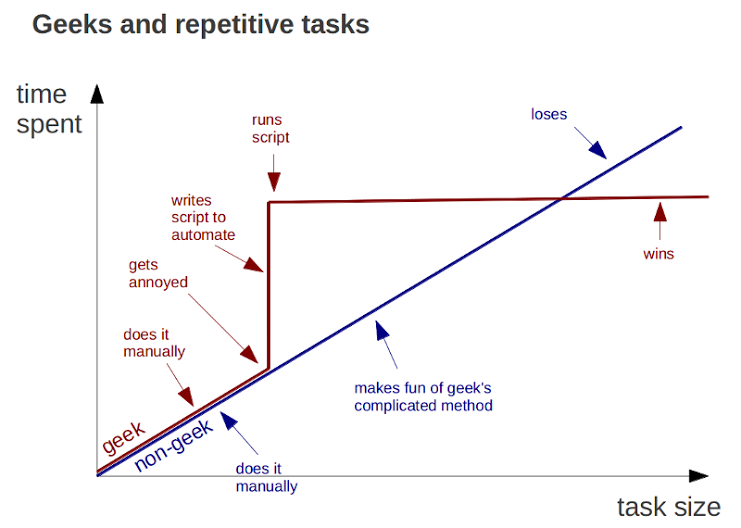
| Robert Heinlein (Time Enough For Love) |
Great graph by Bruno Oliveira; discovered in a nice paper about writing nice R code.

From NASA’s Image of the Day Gallery. Beautiful unannotated images can be seen from ESA’s site.
In this rare image taken on July 19, 2013, the wide-angle camera on NASA’s Cassini spacecraft has captured Saturn’s rings and our planet Earth and its moon in the same frame.

It is only one footprint in a mosaic of 33 footprints covering the entire Saturn ring system (including Saturn itself). At each footprint, images were taken in different spectral filters for a total of 323 images: some were taken for scientific purposes and some to produce a natural color mosaic. This is the only wide-angle footprint that has the Earth-moon system in it.
The dark side of Saturn, its bright limb, the main rings, the F ring, and the G and E rings are clearly seen; the limb of Saturn and the F ring are overexposed. The “breaks” in the brightness of Saturn’s limb are due to the shadows of the rings on the globe of Saturn, preventing sunlight from shining through the atmosphere in those regions. The E and G rings have been brightened for better visibility.
Earth, which is 898 million miles (1.44 billion kilometers) away in this image, appears as a blue dot at center right; the moon can be seen as a fainter protrusion off its right side. An arrow indicates their location in the annotated version. (The two are clearly seen as separate objects in the accompanying narrow angle frame: PIA14949.) The other bright dots nearby are stars. This is only the third time ever that Earth has been imaged from the outer solar system. The acquisition of this image, along with the accompanying composite narrow- and wide-angle image of Earth and the moon and the full mosaic from which both are taken, marked the first time that inhabitants of Earth knew in advance that their planet was being imaged. That opportunity allowed people around the world to join together in social events to celebrate the occasion.
This view looks toward the unilluminated side of the rings from about 20 degrees below the ring plane. Images taken using red, green and blue spectral filters were combined to create this natural color view. The images were obtained with the Cassini spacecraft wide-angle camera on July 19, 2013 at a distance of approximately 753,000 miles (1.212 million kilometers) from Saturn, and approximately 898.414 million miles (1.445858 billion kilometers) from Earth. Image scale on Saturn is 43 miles (69 kilometers) per pixel; image scale on the Earth is 53,820 miles (86,620 kilometers) per pixel. The illuminated areas of neither Earth nor the Moon are resolved here. Consequently, the size of each “dot” is the same size that a point of light of comparable brightness would have in the wide-angle camera.
The Cassini-Huygens mission is a cooperative project of NASA, the European Space Agency and the Italian Space Agency. The Jet Propulsion Laboratory, a division of the California Institute of Technology in Pasadena, manages the mission for NASA’s Science Mission Directorate, Washington, D.C. The Cassini orbiter and its two onboard cameras were designed, developed and assembled at JPL. The imaging operations center is based at the Space Science Institute in Boulder, Colo.
For more information about the Cassini-Huygens mission visit http://www.nasa.gov/cassini and http://saturn.jpl.nasa.gov or European Space Agency’s site at http://www.esa.int/Our_Activities/Space_Science/Cassini-Huygens.
Image Credit: NASA/JPL-Caltech/Space Science Institute
Brand Manage Camp is a marketing and brand conference in Las Vegas. Their blog has been greatly illustrated by Hugh MacLeod alias @gapingvoid.
It would be a pity to restrain the scope of such inspiring work to the narrow scope of brand management… I picked up the best ![]()
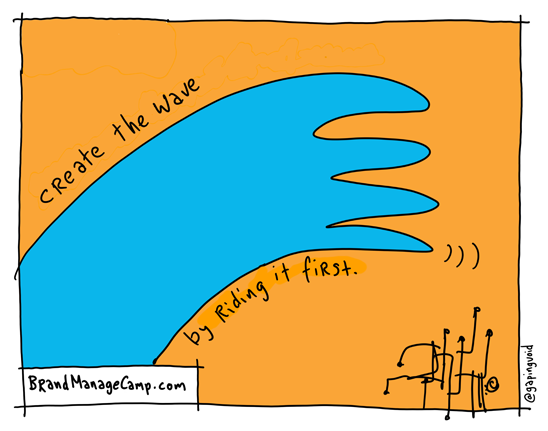
When most laypeople (like myself) speak about surfing, they focus on "catching the wave." Based on my one surfing lesson and viewing the classic Patrick Swayze film Point Break, though, my understanding is that this not exactly correct. It may be more accurate to say that successful surfers don’t really catch waves, they catch swells. The fact is, by the time the wave forms it is too late to catch it and get a high quality ride. Real surfers sit out in the water, studying lumps on the horizon. The biggest lumps can build into swells which then become waves.
If you miss the swell, you will miss the opportunity to build momentum and ride the surge into the wave. Even if you catch the surge, you still have to know where the wave will break. Paddle through the break and the wave will crash on top of you.
I think this is a pretty good metaphor for trends. In order to successfully leverage a trend you have to get ahead of it – but not too far ahead of it Wait too long and it will pass you by. Of course, the ones who are most successful in leveraging trends (as well as the ones who are most successful in surfing waves) are the ones who can see them coming, build their momentum, and catch them at just the right time.
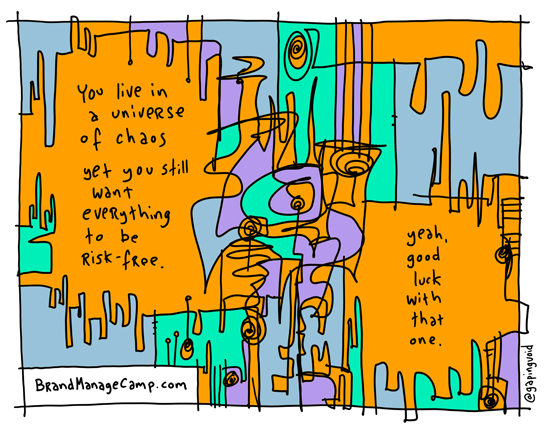
I think that, all too often, people have the wrong attitude when it comes to risk. Risk is not something that can be (or even should be) eliminated. The old cliche "no risk, no reward" is a cliche because it is true. Clearly, whenever we are trying to break new ground, do something new, connect with customers or consumers in a way that has never been done, there is going to be risk. Even if we have been super successful every time before, there is still risk. Just ask Jerry Bruckheimer and Johnny Depp about The Lone Ranger.
If you try to eliminate risk, though, you will undoubtedly be unsuccessful and will go crazy trying. We just cannot control all the elements at play. What we can do, though, is mitigate risk. We can identify, understand, and manage risk. We can hedge risk.
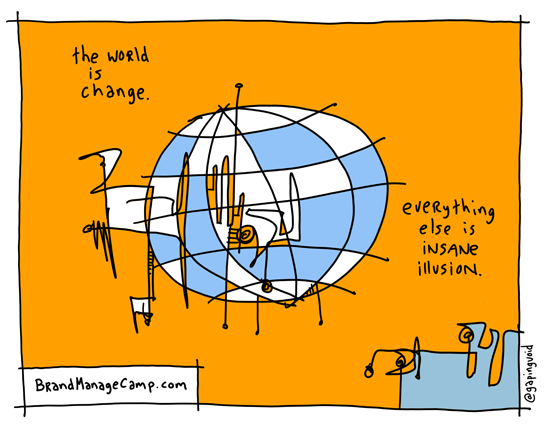
Let’s face it, most people don’t like change. Not only don’t they like it, but they also don’t handle it very well.
During a recent conversation, my daughter crowned an argument by reciting a popular saying.
"The definition of insanity is doing the same thing over and over and expecting different results."
Clever kid.
"Perhaps," I replied.
"But isn’t it also insane to do the same thing over and over and expect the same results?"
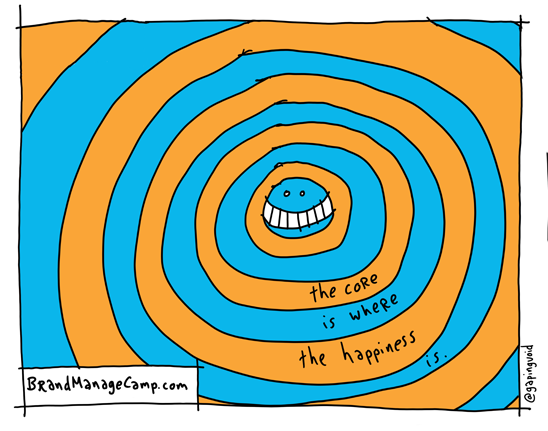
These days it seems all the cool kids are focused on expanding their businesses into new markets. Which, in and of itself, is not a bad thing. As long as you recognize that this is a risky endeavor that, while generating some high profile successes, very often ends in agonizing losses – both in the expansion AND in the original core business. The problems usually begin when the new is pursued at the expense of the core…
You see, the real (and un-sexy) truth is that virtually all top-performing companies achieve their superior results through the more profitable and less risky path of growing their existing position in their core business. Research has proven that it is 5 times cheaper to keep a current customer than acquire a new one!
While, on the surface, this argument seems pretty straightforward, the reality is that in many organizations making the case for growing the core is actually far harder than the sexier approach of going after new targets and markets.
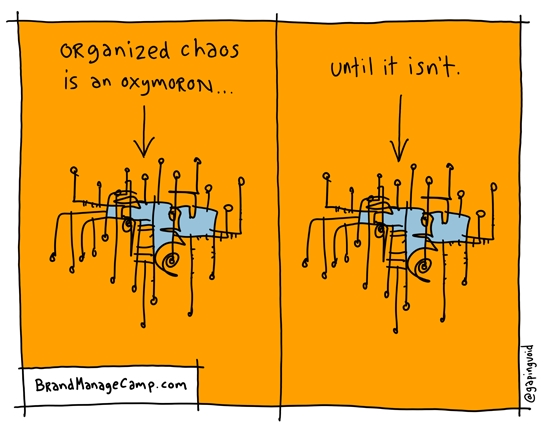
We all spend so much time and effort trying to be organized. Structure, for many people (and organizations) is a coping mechanism that helps us deal with chaos and complexity in terms we understand. In fact, we often avoid chaos and uncertainty like the plague. Unfortunately, history has proven over and over that our biggest opportunities for creating, for innovating, for changing the paradigm, have all come from that which scares us the most – chaos.
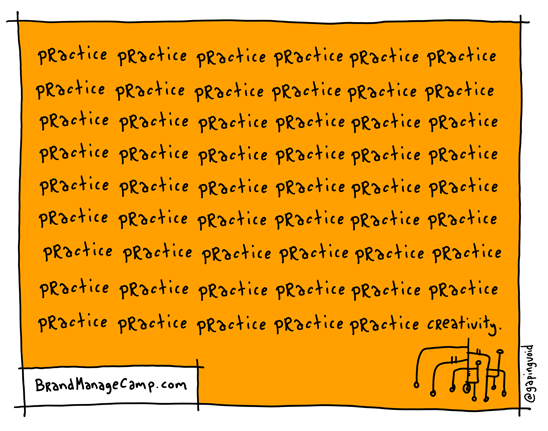
Creativity is something you either have or you don’t, right? WRONG! Here’s the dirty secret the "creatives" don’t want us to know – with very purposeful practice, anyone can set themselves up for creative brilliance.
Great picture from Time.

July 9, 2013. A child is seen near members of the Muslim community attending midday prayers at Strasbourg Grand Mosque in Strasbourg, France on the first day of Ramadan.
What if the Italians had colonized America instead of the British:
From a New York Times interview with Steve Case, conducted and condensed by Adam Bryant:
I think that when people talk about staying small, they’re saying they want to be big but still be nimble and creative and innovative and flexible. They also want to still feel like attackers, not defenders. As companies get larger — and I saw this with AOL even before we merged, but certainly after the merger with Time Warner — we did shift from being an attacker to a defender.
And I realized the world of business really separates into these two groups. The attackers are the entrepreneurs who are disrupting the status quo, trying to change the world, take the hill, anything is possible, and have nothing to lose in most cases. They’re driven by passion and the idea and intensity. Large organizations — and it’s true of Fortune 500s and it’s also true of governments and other large organizations — are defenders. These guys aren’t trying to pursue the art of the possible, how to maximize opportunity. They actually are trying to minimize the downside, and hedge risk. They’re trying to de-risk situations. Entrepreneurs can’t even think this way. It’s not even a concept they understand.
For the traditional executives running these large companies, of course they want to grow, of course they want to innovate, of course they’d rather have revenue grow faster than slower, but they mostly don’t want to lose what they’ve got. But entrepreneurs are deathly afraid that they won’t be able to change the world, and that somebody else will. Again, these generalizations are a little unfair, but corporate executives are all too often deathly afraid that the business they inherit will be less valuable when they leave than when they started.
Retranscription d’une petite chronique en 4 tweets par Perruche automnale (@PUautomne), néphrologue blogueur :
Dans la série l’humanité est belle. Vieille, démente, dialysée, après sa séance les ambulanciers la ramènent et trouvent porte close.
Sur la porte, un mot : «nous sommes partis en voyage, merci de prendre soin de notre mère». Les ambulanciers nous rappellent
Retour dans le centre et hospitalisation, que faire d’autre un samedi à 14h, on fait SPDA aujourd’hui
SPDA: société protectrice des dialysés abandonnés, je précise le sens de cet acronyme du jour.
Thanks to Tina Roth Eisenberg (@swissmiss), we can enjoy 20 great minutes by Seth Godin (@ThisIsSethsBlog):
You can find the Q&A following his talk here.
Bonus: The famous picture of the 1927 Solvay Conference, titled "Électrons et photons".
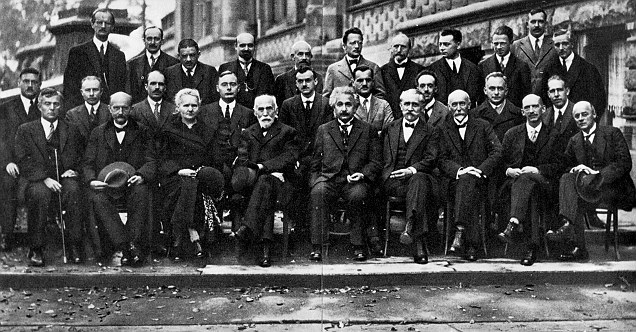
A. Piccard, E. Henriot, P. Ehrenfest, E. Herzen, Th. de Donder, E. Schrödinger, J.E. Verschaffelt, W. Pauli, W. Heisenberg, R.H. Fowler, L. Brillouin;
P. Debye, M. Knudsen, W.L. Bragg, H.A. Kramers, P.A.M. Dirac, A.H. Compton, L. de Broglie, M. Born, N. Bohr;
I. Langmuir, M. Planck, M. Skłodowska-Curie, H.A. Lorentz, A. Einstein, P. Langevin, Ch.-E. Guye, C.T.R. Wilson, O.W. Richardson
Petite Poucette (aka Thumbelina), the book by Michel Serres, convinced me that teaching should never ever remain the same old story. Here are some complementary viewpoints on this topic:
In Math You Have to Remember, In Other Subjects You Can Think About It by Keith Devlin.
Why I Let My Students Cheat On Their Exam by Peter Nonacs

C’est un beau texte du Journal des étudiants en médecine, mais la fin ne me plait pas ; elle utilise un vocabulaire daté et inapproprié. Je l’ai signalé à l’auteur, mais il m’a répondu qu’il n’était pas sûr que les lecteurs comprennent s’il adaptait son discours. J’ai décidé de faire le test… avec ci-dessous un texte modifié.
Alors voila 12 heures de garde avec M., nouvelle externe, inconnue au bataillon, deux ans plus jeune que moi. En 12 heures, j’observe sa manière de faire, assez épaté par sa douceur, son savoir-faire.
Elle examine les gens, pose ses mains avec dextérité, sait quoi regarder, où chercher, toujours avec d’infinies précautions.
Elle traite les patients tel un collectionneur ses porcelaines.
On échange deux/trois mots. M. a un petit accent charmant… Je réfléchis : "Italienne ? Roumaine ? Espagnole ?".
Le programme Erasmus a du bon : depuis sa création 1 million d’enfants sont nés grâce aux couples que cela a formé. Loin de moi l’idée de vouloir un bébé mais, à l’époque, je me souviens m’être dit que j’essaierais bien deux/trois fois avec elle (oui, oui on est tous pareils…).
12 heures passent.
Elle : "J’ai apprécié travailler avec toi mais tu parles trop vite pour que je comprenne".
- De quel pays viens-tu ?
- Je suis française.
Je me sens con, je dis :
- Mais, tu as ce petit accent…
Elle me sourit (ironie ? fierté incommensurable ?) et dit trois mots :
- Je suis sourde.
Elle soulève ses cheveux, montre son appareillage, avant d’ajouter :
- Et tu parles beaucoup trop vite pour que je lise sur tes lèvres correctement.
Il n’y a pas d’incapacité qui soit condamnée à constituer un handicap, je veux dire : il n’y a VRAIMENT pas d’incapacité qui soit condamné à constituer un handicap.
Je n’ai modifié que la phrase finale, qui disait "Il n’y a pas de handicap qui ne puisse pas être battu"
La terminologie moderne distingue bien la limitation fonctionnelle ou l’incapacité qui qualifient la personne et le handicap qui désigne l’interaction entre cette personne et son environnement.
Le terme handicap devrait être réservé au manque d’adaptation d’un environnement à une limitation ou une incapacité. L’utiliser pour désigner l’ensemble, c’est risquer d’être ambigu, mais surtout adopter une logique implicitement passive.
Il y a un écart considérable entre affirmer Vous êtes handicapé (c’est triste, mais on n’y peut rien) et Cet environnement inadapté vous handicape (et il faut qu’on l’adapte).

Boston design director Brian Struble used running shoes worn in last week’s Boston marathon to create this image. Photograph by Mitch Feinberg.
Smithsonian magazine just announced the 50 finalists in its 10th annual photo contest.
Here are my votes:

Photo by Colleen Pinski (Peyton, CO). Photographed in Albuquerque, NM, May 2012.
The photographer captures a person framed by the annular solar eclipse, watching as the sun sets. "I feel it can inspire so many people around the world, no matter what race, religion or gender," Pinski says. "Anyone can look at it and feel touched by a ‘beyond this world’ experience."

Photo by Jason J. Hatfield (Lakewood, CO). Photographed in Bryce Canyon National Park, UT, May 2012.
A hiker looks onto the path before him in Bryce Canyon National Park in the middle of the night as the Milky Way stretches upward above. The photographer, who used a Sony A900, had been shooting the day’s solar eclipse.

Photo by Bob Bush (Altadena, CA). Photographed in Namibia, May 2010.
A lone acacia tree stands in the burnt sienna sands of the Namibian desert against the rising sun. "The acacia tree provided a sense of scale and a sense of the beautiful desolation of the place," says the photographer, who used a Nikon 300S.

Photo by Hai Thinh Hoang (Hanoi, Vietnam). Photographed in Bac Son, Lang Son, Vietnam, July 15, 2012.
The photographer climbed up a mountain for two hours, reaching an altitude of 617 meters, to achieve this shot of an early fog floating over yellow rice paddies. The camera used is a Nikon D3S.
Nearly 18 months since my previous post about visions of a possible future.
Microsoft just released a new sequel:
Nothing really new under the sun… and if you have a look to this already five years old health focused vision you may share my feelings that today’s future is under-promising compared to yesterday’s visions.